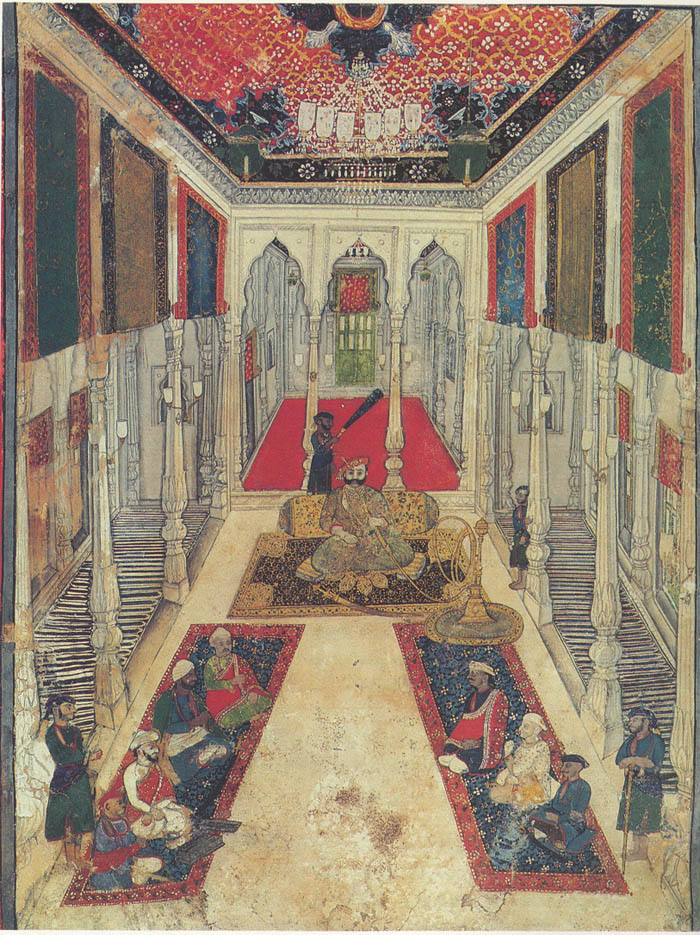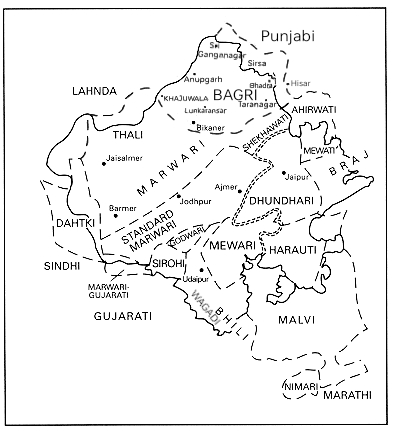|
Luni, Rajasthan
Luni is a town in Jodhpur district of the Indian state of Rajasthan. It is located 35 km South from Jodhpur district headquarter. Luni is also the headquarter of Luni tehsil. Geography Luni is located in Central Rajasthan on the banks of the Luni River. Luni is near the villages of Shikarpura, Satlana, French, and Barliya. The nearest city, the District capital of Jodhpur, is 35 km (22 mi) away. The artisans inhabiting the village pursue their ancestral profession of fashioning metal, clay or wood into intricate forms. Climate During the summer, the temperature can go as high as . In the winter, it can range from 15 degrees to 25 degrees. Nights are cool and days are hot and humid. Tourist attractions in Luni Fort Chanwa Fort Chanwa is a red sandstone fort. It was built around 1895 by Kaviraja Muraridan of Bhandiyawas who received Luni as jagir during the rule of Jaswant Singh II, Maharaja Jaswant Singh II of Marwar. The red sandstone was brought from Jodhpur ... [...More Info...] [...Related Items...] OR: [Wikipedia] [Google] [Baidu] |
Jodhpur Rural District
Jodhpur Gramin district (translated as: Jodhpur Rural) was a List of districts of Rajasthan, district in Rajasthan state of India. This district was formed in 7 August 2023. Its administrative headquarters was Jodhpur district. 2024 updates On 28 December 2024, the Cabinet of Rajasthan decided not to retain 9 new districts- Anupgarh, Dudu, Gangapur City, Jaipur Rural, Jodhpur Rural, Kekri, Neem Ka Thana, Sanchore, and Sanchore, and Shahpura- along with the 3 newly created divisions—Banswara, Pali, and Sikar. See also * Jodhpur * Jodhpur district * Jaipur district * Jaipur Gramin district * List of districts of Rajasthan * Jodhpur Lok Sabha constituency References Districts of Rajasthan Districts in Jodhpur division {{Jodhpurdivision-geo-stub ... [...More Info...] [...Related Items...] OR: [Wikipedia] [Google] [Baidu] |
Indian Standard Time
Indian Standard Time (IST), sometimes also called India Standard Time, is the time zone observed throughout the Republic of India, with a time offset of UTC+05:30. India does not observe daylight saving time or other seasonal adjustments. In military and aviation time, IST is designated E* ("Echo-Star"). It is indicated as ''Asia/Kolkata'' in the IANA time zone database. History The Indian Standard Time was adopted on 1 January 1906 during the British era with the phasing out of its precursor Madras Time (Railway Time), and after Independence in 1947, the Union government established IST as the official time for the whole country, although Kolkata and Mumbai retained their own local time (known as Calcutta Time and Bombay Time) until 1948 and 1955, respectively. The Central observatory was moved from Chennai to a location at Shankargarh Fort in Allahabad district, so that it would be as close to UTC+05:30 as possible. Daylight Saving Time (DST) was used brief ... [...More Info...] [...Related Items...] OR: [Wikipedia] [Google] [Baidu] |
The Times Of India
''The Times of India'' (''TOI'') is an Indian English-language daily newspaper and digital news media owned and managed by the Times Group. It is the List of newspapers in India by circulation, third-largest newspaper in India by circulation and List of newspapers by circulation, largest selling English-language daily in the world. It is the oldest English-language newspaper in India, and the second-oldest Indian newspaper still in circulation, with its first edition published in 1838. It is nicknamed as "The Old Lady of Bori Bunder", and is a newspaper of record. Near the beginning of the 20th century, Lord Curzon, the Viceroy of India, called ''TOI'' "the leading paper in Asia". In 1991, the BBC ranked ''TOI'' among the world's six best newspapers. It is owned and published by Bennett, Coleman & Co. Ltd. (BCCL), which is owned by the Sahu Jain family. In the Brand Trust Report India study 2019, ''TOI'' was rated as the most trusted English newspaper in India. In a 2021 surve ... [...More Info...] [...Related Items...] OR: [Wikipedia] [Google] [Baidu] |
Jaswant Singh II
Jaswant Singh II, GCSI, (1838 – 11 October 1895) was Maharaja of Jodhpur from 4 February 1873 – 11 October 1895. Birth He was born in 1838 at Ahmadnagar in Gujarat and was eldest son of Takht Singh and his consort, Maharani Gulab Kanwar, daughter of Maharaja Sheo Singh of Sirohi. He ruled during the time of Aurangzeb. Marriage He had eight wives, of which the first was the daughter of the Jam Sahib of Nawanagar, Rajba Kanwar. Puariji Bijay Kanwar was his chief consort and mother of Maharaja Sardar Singh. Accession He acceded to the throne of Jodhpur in 1873 upon death of his father, Takht Singh, Reign The reign of Jaswant Singh II was marked with remarkable prosperity and reforms and development works. He established Courts of Justice, introduced system of revenue settlement and reorganizing all the state departments. Further, he developed infrastructure of the state by introducing telegraphs, railways ( Jodhpur State Railway), and developing roads.Indian States: A ... [...More Info...] [...Related Items...] OR: [Wikipedia] [Google] [Baidu] |
Jagir
A jagir (), ( Hindustani: जागीर/جاگیر, ''Jāgīr''), ( Marathi: जहागीर, ''Jahāgīrá'') also spelled as jageer, was a type of feudal land grant in the Indian subcontinent at the foundation of its Jagirdar ( Zamindar) system. It developed during the Islamic era of the Indian subcontinent, starting in the early 13th century, wherein the powers to govern and collect tax from an estate was granted to an appointee of the state. 13th-century origin and successors This feudal system of land ownership is referred to as the ''jagirdar'' system. The system was introduced by the Sultans of Delhi from the 13th century onwards, was later adopted by the Mughal Empire, the Maratha Empire and continued under the British East India Company. Some Hindu jagirdars were converted into Muslim vassal states under Mughal imperial sway, such as the nawabs of Kurnool. Most princely states of India during the colonial British Raj era were jagirdars such as Mohrampur Jagi ... [...More Info...] [...Related Items...] OR: [Wikipedia] [Google] [Baidu] |
Kaviraja Muraridan
Mahamahopadhyaya Kaviraja Muraridan Ashiya (1830 — 1914) served as the Dewan (Prime Minister) of Marwar during the reign of Jaswant Singh II (1873–1895). Kaviraja is remembered as an astute politician and a farsighted administrator, who made significant contributions to the history of Marwar. He was a Tazimi sardar (noble) and a renowned scholar, known for his prominent works including ''Yaśavaṃta-Yaśo-Bhūṣaṇa'' and ''Tawarikh Marwar.'' Early life and family Kaviraja Muraridan was born in 1830 into the prominent family of Bhandiyawas. His father, Kaviraja Bharatdan, and grandfather, Kaviraja Bankidas, were renowned scholars-historians and administrators of the kingdom of Marwar. During his childhood, Muraridan learned bhasha-sahitya and Dingal from his father Bharatdan, Yati Jnanchandra taught him Sanskrit. Career At the age of sixteen, Muraridan joined the court of Maharaja Takhat Singh and held various administrative positions under him and later rulers, i ... [...More Info...] [...Related Items...] OR: [Wikipedia] [Google] [Baidu] |
Luni River
The Luni is the largest river in the Thar Desert in Northwest India. It originates in Naga hills of the Pushkar valley of the Aravalli Range, near Ajmer, passes through the southeastern portion of the Thar Desert, and ends in the marshy lands of Rann of Kutch in Gujarat, after travelling a distance of . It is first known as Sagarmati, then after passing Govindgarh, it meets its tributary Sarasvati, which originates from Pushkar Lake and from then on it is called Luni., see also The Imperial Gazetteer of India In 1892, Maharaja Jaswant Singh II of Jodhpur constructed 0 in Pichiyak village between Bilara and Bhawi of Jodhpur district. It is one of the largest artificial lakes in India and irrigates more than . It is one of the internal drainage rivers in India; it does not meet with Arabian Sea. It is drained before it reaches the Arabian Sea. Etymology The Luni is also known as the Lavanavari or Lavanavati, which means "salt river" in Sanskrit, due to the high salinity of it ... [...More Info...] [...Related Items...] OR: [Wikipedia] [Google] [Baidu] |
Postal Index Number
A Postal Index Number (PIN; sometimes redundantly a PIN code) refers to a six-digit code in the Indian postal code system used by India Post. On 15 August 2022, the PIN system celebrated its 50th anniversary. History The PIN system was introduced on 15 August 1972 by Shriram Bhikaji Velankar, an additional secretary in the Government of India, Government of India's Ministry of Communications (India), Ministry of Communications. The system was introduced to simplify the manual sorting and delivery of mail by eliminating confusion over incorrect addresses, similar place names, and different languages used by the public. PIN structure The first digit of a PIN indicates the zone, the second indicates the sub-zone, and the third, combined with the first two, indicates the sorting district within that zone. The final three digits are assigned to individual post offices within the sorting district. Postal zones There are nine postal zones in India, including eight regional zon ... [...More Info...] [...Related Items...] OR: [Wikipedia] [Google] [Baidu] |
Rajasthani Language
The Rajasthani languages are a group of Western Indo-Aryan languages, primarily spoken in Rajasthan and Malwa, and adjacent areas of Haryana, Gujarat and Madhya Pradesh in India and South Punjab and the adjacent areas of Sindh in Pakistan. They have also reached different corners of India, especially eastern and southern parts of India, due to the migrations of people of the Marwari community who use them for internal communication. Rajasthani languages are also spoken to a lesser extent in Nepal, where they are spoken by 25,394 people according to the 2011 Census of Nepal. The term Rajasthani is also used to refer to a literary language mostly based on Marwari.. Geographical distribution Most of the Rajasthani languages are chiefly spoken in the state of Rajasthan but are also spoken in Gujarat, Western Madhya Pradesh i.e. Malwa and Nimar, Haryana and Punjab. Rajasthani languages are also spoken in the Bahawalpur and Multan sectors of the Pakistani provinces of Punjab an ... [...More Info...] [...Related Items...] OR: [Wikipedia] [Google] [Baidu] |
States And Territories Of India
India is a federalism, federal union comprising 28 federated state, states and 8 union territory, union territories, for a total of 36 subnational entities. The states and union territories are further subdivided into 800 List of districts in India, districts and smaller administrative divisions of India, administrative divisions by the respective subnational government. The states of India are self-governing administrative divisions, each having a State governments of India, state government. The governing powers of the states are shared between the state government and the Government of India, union government. On the other hand, the union territories are directly governed by the union government. History 1876–1919 The British Raj was a very complex political entity consisting of various imperial divisions and states and territories of varying autonomy. At the time of its establishment in 1876, it was made up of 584 princely state, constituent states and the prov ... [...More Info...] [...Related Items...] OR: [Wikipedia] [Google] [Baidu] |





